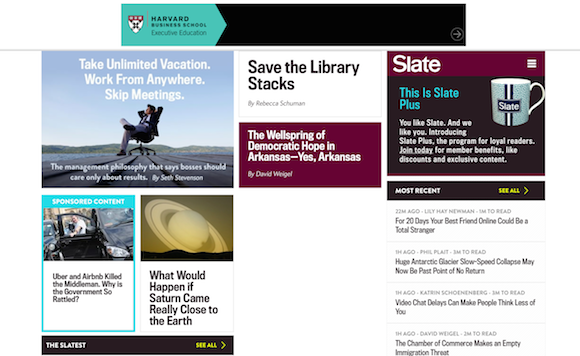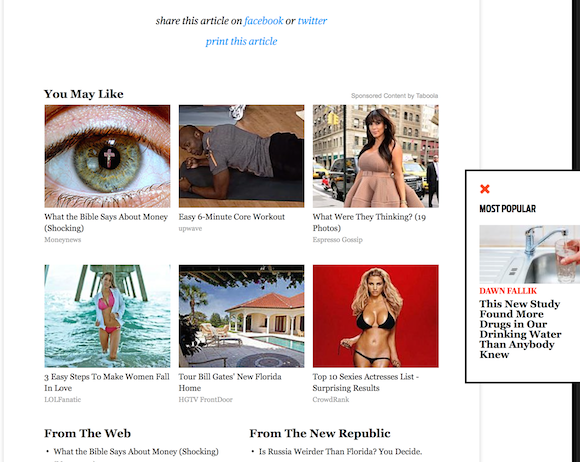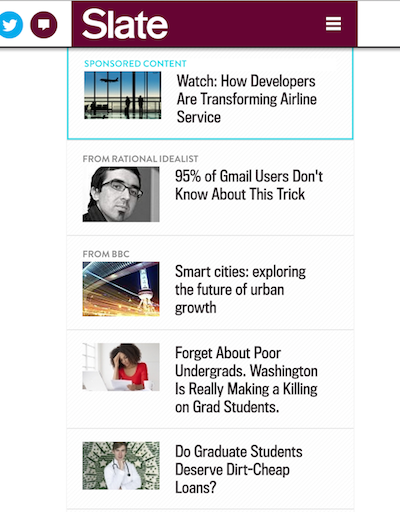The big paradox for journalism on the internet is that the medium offers so many technical advantages—infinite space, malleable design, greater intimacy with readers, etc. —yet remains a colossally, stubbornly, maddeningly difficult place to make a buck.
Every news organization, new and old, has had to grapple with this paradox. Sometimes in doing so, they wander into murky ethical swamps. Take Slate.
Slate’s redesign, launched last September, looks like it was designed “to make everything look like sponsored content,” noted the journalist Lindsay Beyerstein at the time— but that’s not the main problem.

That’s what the home page looks like as I write this, with a native ad on the far left that’s very clearly labeled as such.
No problem there.
Click on a Slate story, though, and things get murkier. The sidebar on the far right mixes Slate content with links to other sites, including Time, the BBC, and The Week, as well as in-house links to the new Slate Plus and to sister site The Root. All of the “refers” look alike, though the external links include gray text up top that says “From Time” or “From Computer World.”
If you didn’t know better, you might think Slate is doing readers a service with “good” aggregation: linking to stories at other sites it thinks you should read.
But Slate is actually getting paid for all those links, and they aren’t curated by Slate but by a marketing company called Outbrain.
Founded in 2006, Outbrain is part of what is known as the content-recommendation industry, which are paid by advertisers to place ads on websites and do so according to computer algorithms that try to predict what sites and what articles—indeed which readers—would be most likely to generate a click. When readers do click, Outbrain is paid by the advertiser and gives a cut to the referring site.
The content recommendation business has gotten a bad reputation over the years, deservedly so, for cluttering up pages, for diluting publisher brands, and for taking on dubious advertisers. Generally speaking, this is the stuff at the bottom of the page that says things like: “95 Percent of Gmail Users Don’t Know About This Trick.” It’s the kind of background noise that we’ve trained ourselves to tune out on the internet: Once you start paying attention to it, it’s everywhere.
Here, for instance, is an ad module from an Outbrain competitor, Taboola, at the august New Republic:

Tacky as they may be, these ads bring in real money. High-traffic publishers can make more than a million dollars a month by placing a module from Outbrain or Taboola at the bottom of their stories. That’s a lot of money on the internet, which has flummoxed publishers for two decades now with rock-bottom and, in recent years, declining rates.
And that’s when the content-recommendation ads are placed in clearly demarcated boxes below stories.
To make things murkier, many publishers, including news organizations, hire Outbrain and other recommenders to place their links on other MSM sites, essentially buying traffic for their site. Why? In many cases, it’s a form of ad arbitrage. A publisher might pay Outbrain seven cents per pageview, but might be getting 10 cents from its own advertisers.
That’s what’ s going on on at Slate—not that Slate will tell you this. And Slate takes it a step further than most other sites. It lifts the Outbrain ads from the bottom of the page to a right-hand rail, mixing in its own content. So the right rail here…

… isn’t entirely curation, per se, but a mix of curation and marketing.
The BBC, for instance, pays Slate, via Outbrain, for clicks on its “Future” vertical sponsored by Chinese telecom giant Huawei (under serious scrutiny in the UK about whether it enables Chinese spying, which might explain why it’s trying to boost its brand at the Beeb). Links to the BBC sponsored content show up alongside actual Slate editorial fare (e.g. “Forget About Poor Undergrads. Washington Is Really Making a Killing on Grad Students”) on Slate’s own site, with no clear indication that they’re ads. The BBC did not respond to requests for comment.
Slate Editor David Plotz, in an email, says non-Slate content is clearly labeled as such, and readers can figure it out.”Our partnership with Outbrain is like that of all their partners: They put links on our pages, generally to editorial sites seeking traffic,” he says. “They are identified clearly as not being from Slate. We are paid for those links.”
Asked if it’s a problem if readers think Slate is sending them to these outside links on its own editorial judgment, Plotz writes, “I don’t think that readers think that.”
Outbrain and Slate send readers not only to publishers like the BBC and Time, but also to lesser-known sites that turn out to be pure ads: like The Financialist, Metro Chatter, and Downshift Cycling. Click on The Financialist’s #slatepitch-y “How to Fix Classroom Education: Get Rid of It,” and you’re taken to a branded content site (aka an ad) run by the big investment bank Credit Suisse. Click on the Metro Chatter and Downshift Cycling links and you find blog posts extolling SaneBox, an email-management startup, on something called the Rational Idealist. And even that’s not what it seems. In fact, it is Sanebox that is buying clicks for Rational Idealist, which has a glowing review of its product.
What’s happening here is that Slate is linking to an ostensibly legit “blog” that is ostensibly posting a legit product review. But the reviewers, in fact, are paid, which is why much of the copy is the exact same or very similar. It’s all marketing.
Dmitri Leonov, Sanebox’s vice president of growth, writes this in an email, “Lots of our users are bloggers, and our affiliate program offers them a payment for each new customer that comes from their blog. We do offer them the content to use as a baseline, but it’s certainly concerning that they are not varying it – at all.”
The biggest deal in the world? No. But, as Dean Starkman wrote, this is the existential problem with native ads: The blurrier the line between them and editorial content, the better they work—but the more damage they do to the editorial brand and the more of a slog the internet is for readers.
Lisa Lacour, Outbrain’s vice president of marketing, tells me the content recommending business represents a great opportunity for publishers—real money as well as extra, interesting content, as along as the proper balance is struck. Actually, Outbrain has tried to go upmarket from competitors, purging scammy content marketers from its system, a move that Outbrain said cost about a quarter of its revenue.
“We said look, we can take what you’ve historically thought of as internet wasteland, below the fold, and monetize it—not just with teeth whitening ads, but with good content,” Lacour says. “The intention of Outbrain, and I would hope all of our publishing partners, is to not try to trick anyone,” Lacour says. “We’re all about transparency and authenticity. Are we all fantastic and great at it at this point? No. And we’re trying to figure out the best way.”
And that’s why Slate’s decision to mix paid links with its editorial offerings is problematic. Any paid link Outbrain posts is advertising, even if it’s purchased by a legitimate publisher trying to hawk its own legitimate content. The news becomes the advertisement on Outbrain and Taboola.
(headline updated to remove quotes from around BBC)
Ryan Chittum is a former Wall Street Journal reporter, and deputy editor of The Audit, CJR’s business section. If you see notable business journalism, give him a heads-up at rc2538@columbia.edu. Follow him on Twitter at @ryanchittum.
